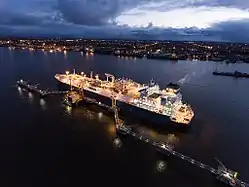Klaipėda LNG FSRU
Klaipėda liquefied natural gas floating storage and regasification unit terminal or Klaipėda LNG FSRU (Lithuanian: Klaipėdos suskystintų gamtinių dujų terminalas) is a LNG terminal in the port of Klaipėda, Lithuania. It cost US$128 million to construct.[1] The project operator is Klaipedos Nafta.
| Klaipėda liquefied natural gas floating storage and regasification unit terminal | |
|---|---|
 Main vessel of the terminal | |
| Location | |
| Country | Lithuania |
| Location | Kiaulės Nugara, Klaipėda |
| Details | |
| Opened | 2014 |
| Owned by | Klaipėdos Nafta |
| Type of harbor | liquified natural gas terminal |
| Available berths | 1 (Platform for LNG tankers) |
| Statistics | |
| Website www | |



The terminal started operating on 3 December 2014.[2] After the completion of the Klaipėda LNG FSRU, Lithuania became the fifth country in the world to use FSRU technology for liquefied natural gas.[3]
History
On 22–27 January 2014 pilot test was conducted in order to assess the FSRU Independence's performance and seaworthiness. Later on the vessel sailed to the sea and the ship's sea trial lasted nearly a week. Earlier, in the beginning of January the ship's propulsion system was tested, later crew safety equipment and other range of testing conducted.[4] It was delivered in March 2014 and was reached the terminal on 27 October 2014.[5]
On June 2014 supplying platform was finished to be built in Kiaulės Nugara.[6] It is one of the four main elements of 450-metre (1,480 ft) length embankment (together with mounting and mooring field, steel bridges and high-pressure gas platform).
On 27 October 2014 the main vessel arrived to Klaipėda's Port. The welcoming ceremony of Independence arrival was broadcast live by national broadcaster LRT televizija, while the ship was greeted by Lithuanian President Dalia Grybauskaitė. Representatives from Latvia, Estonia, Norway, the United States, Finland, Sweden and European Council also participated at the opening.[7]
On 3 December 2014 the terminal started operating.[2]
On October 27, 2017 LNG Distribution Station at Klaipėda Port started operating. Station is dedicated to create a comprehensive LNG logistics chain in the Baltic region.[8]
On January 7, 2019 the world's largest liquefied natural gas transportation and bunkering vessel Kairos, owned by KN and German company Nauticor, was launched at that time. The ship's main activity in Klaipeda port is to transport LNG from the LNG terminal to LNG distribution station.[9]
Storage and regasification vessel
FSRU Independence, a LNG carrier built by Hyundai Heavy Industries, is designed as a floating LNG storage and regasification unit for the terminal. It is leased from Höegh LNG for 10 years with an option of buyout.[1] It has a maximum capacity to handle of almost 4 billion cubic metres per annum (140 billion cubic feet per annum) of natural gas (2.2 million tonnes of LNG), while it has four storage tanks with total capacity of 170,000 cubic metres (6,000,000 cu ft).[1][10] However, until the end of 2015, the maximum capacity is to 2 billion cubic metres per annum (71 billion cubic feet per annum) due to limited pipeline capacity between Lithuania and underground storage in Latvia, and due to a closed gas market in Latvia.
Supply
Equinor is contracted to supply LNG for five years to cover the minimum operational need of the terminal.[1] In 2015, Equinor will supply 540 million cubic metres (19 billion cubic feet) of natural gas.[11] The first test cargo was delivered on 28 October 2014 by LNG tanker Golar Seal.[12] Gas was originating from the Snøhvit field (Melkøya LNG plant). It was imported by Litgas, a subsidiary of Lietuvos Energija.[10]
Awards
At the 8th European Gas Conference 2015 in Vienna, Austria Klaipėda LNG FSRU won the Project of the Year award.[13]
References
- Seputyte, Milda (2014-10-27). "Lithuania Grabs LNG in Effort to Curb Russian Dominance". Bloomberg Businessweek. Bloomberg. Archived from the original on 2014-10-27. Retrieved 2014-10-27.
- Pradeda veikti SGD terminalas. Vakarų ekspresas, 2014-12-03
- World's LNG Liquefaction Plants and Regasification Terminals
- "FSRU 'Independence' successfully sailed off on a sea trial". Archived from the original on 2014-02-11. Retrieved 2014-02-11.
- Į Klaipėdą atplaukė laivas "Independence"
- Masiulis apie SkGD: jau matyti pabaigos pradžia
- "Floating LNG terminal "Independence" sails into Klaipėda". Delfi. 2014-10-27. Retrieved 2014-10-28.
- https://www.kn.lt/naujienos/naujienos/paskelbta-klaipedos-sgd-paskirstymo-stoties-simboline-eksploatacijos-pradzia/2074
- https://www.kn.lt/naujienos/naujienos/sgd-paskirstymo-stoti-aptarnausiantis-laivas-pradeda-pirmaja-krovos-operacija-klaipedoje-/2812
- "Golar Seal to deliver Lithuania's first LNG cargo". Argus Media. 2014-10-27. Retrieved 2014-10-27.
- "Lithuania Looks To LNG Terminal To Breaking Russian Monopoly". RFE/RL. 2014-10-27. Retrieved 2014-10-27.
- Bandomasis dujų krovinys - jau Klaipėdoje. Vakarų ekspresas, 2014-10-28
- Lithuanian LNG terminal wins European gas project of the year award